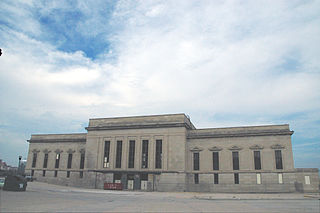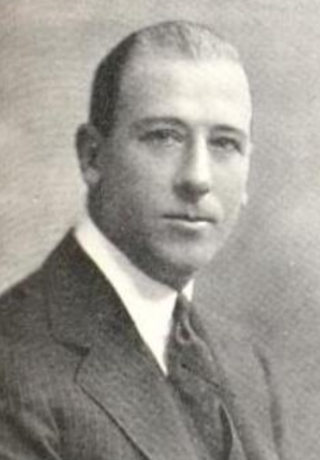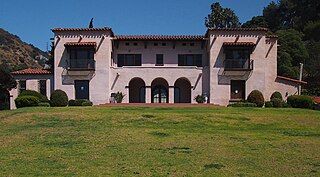
Omaha is the most populous city in the U.S. state of Nebraska and the county seat of Douglas County. Omaha is in the Midwestern United States on the Missouri River, about 10 mi (15 km) north of the mouth of the Platte River. The nation's 40th-most populous city, Omaha's 2020 census population was 486,051.

The Trans-Mississippi and International Exposition was a world's fair held in Omaha, Nebraska, from June 1 to November 1 of 1898. Its goal was to showcase the development of the entire West from the Mississippi River to the Pacific Coast. The Indian Congress was held concurrently. Over 2.6 million people came to Omaha to view the 4,062 exhibits during the five months of the Exposition. President William McKinley and William Jennings Bryan were among the dignitaries who attended at the invitation of Gurdon Wattles, the event's leader. A hundred thousand people assembled on the plaza to hear them speak. The Expo stretched over a 180-acre (0.73 km2) tract in North Omaha and featured a 2,000-foot-long (610 m) lagoon encircled by 21 classical buildings that featured fine and modern products from around the world.

John Hopwood Mickey was an American banker and Republican politician who served as the 13th Governor of Nebraska from 1903 to 1907.

The Union Stock Yards Company of Omaha was a 90-year-old company first founded in South Omaha, Nebraska in 1878 by John A. Smiley. After being moved to Council Bluffs, Iowa and dissolved within a year, the company was reorganized and moved to South Omaha in 1883. Six local businessmen responded to a request by Wyoming cattle baron Alexander Swan showing interest in a livestock market closer than the Union Stock Yards in Chicago, Illinois. The Company's Union Stockyards in South Omaha were once a fierce rival of Chicago's Union Stock Yards. The Union Stock Yards Company of Omaha was bought out in 1973.
Czechs in Omaha, Nebraska have made significant contributions to the political, social and cultural development of the city since the first immigrants arrived in 1868.

Transportation in Omaha, Nebraska, includes most major modes, such as pedestrian, bicycle, automobile, bus, train and airplane. While early transportation consisted of ferries, stagecoaches, steamboats, street railroads, and railroads, the city's transportation systems have evolved to include the Interstate Highway System, parklike boulevards and a variety of bicycle and pedestrian trails. The historic head of several important emigrant trails and the First transcontinental railroad, its center as a national transportation hub earned Omaha the nickname "Gate City of the West" as early as the 1860s.

Railroads in Omaha, Nebraska, have been integral to the growth and development of the city, the state of Nebraska, the Western United States and the entire United States. The convergence of many railroad forces upon the city was by happenstance and synergy, as none of the Omaha leaders had a comprehensive strategy for bringing railroads to the city.

Edward Aloysius Cudahy Jr., also known as Eddie Cudahy, was kidnapped on December 18, 1900 in Omaha, Nebraska. Edward Cudahy Sr. was the wealthy owner of the Cudahy Packing Company, which helped build the Omaha Stockyards through the 1950s. Cudahy Sr. paid the ransom for the return of his son and made the kidnapper, Pat Crowe, a popular author, lecturer and actor for a brief period. The Cudahy case is said to have influenced many succeeding kidnappings, including those of the Lindbergh baby, Bobby Greenlease, and Marion Parker.
Jack Broomfield (1865–1927) was an African-American community activist and political leader in Omaha, Nebraska in the early 20th century.

Jesse Lowe was the first mayor of Omaha, Nebraska, serving for one year from March 5, 1857 to March 2, 1858. An important real estate agent in the early city, Lowe is credited with naming the city after the Omaha Tribe.

The Wattles Estate, originally known as Jualita, is a historic house and park in the Hollywood area of Los Angeles, California, United States. It was built in 1907 by wealthy Omaha, Nebraska, banker Gurdon Wattles as a winter home. Next to the Wattles Mansion are Wattles Park and Wattles Gardens, now administered by the City of Los Angeles and open to the public.
The Omaha and Council Bluffs Railway and Bridge Company, known as O&CB, was incorporated in 1886 in order to connect Omaha, Nebraska with Council Bluffs, Iowa over the Missouri River. With a sanctioned monopoly over streetcar service in the two cities, the O&CB was among the earliest major electric street railway systems in the nation, and was one of the last streetcar operators in the U.S., making its last run in 1955.
Credit Foncier of America was a late 19th-century financing and real estate company in Omaha, Nebraska. The company existed primarily to promote the townsites along the Union Pacific Railroad, and was incorporated by a special act of the Nebraska Legislature in 1866. Credit Foncier was said to be "intimately connected with all the early towns along the Union Pacific."
Reuben Gaylord was the recognized leader of the missionary pioneers in the Nebraska Territory, and has been called the "father of Congregationalism in Nebraska." Writing in memory of Gaylord in the early 1900s, fellow Omaha pioneer George L. Miller said, "It was Reuben Gaylord, the brave Christian soldier who brought Sunday into Omaha and the Trans-Missouri country.
The Irish in Omaha, Nebraska have constituted a major ethnic group throughout the history of the city, and continue to serve as important religious and political leaders. They compose a large percentage of the local population.
The Omaha Traction Company was a privately owned public transportation business in Omaha, Nebraska. Created in the early 1900s by wealthy Omaha banker Gurdon Wattles, the company was involved in a series of contentious disputes with organized labor.
Enos Lowe was a pioneer doctor and businessman who was among the original founders of Omaha, Nebraska, and served as president of the Second Iowa Constitutional Convention.
The First Nebraska Territorial Legislature first met in Omaha, Nebraska, on January 15, 1855. The Council Bluffs and Nebraska Ferry Company provided the first meeting place, which was a building "constructed for public purposes". Standing out from the estimated twenty shacks in the young town, it was the first brick building in Omaha, which was founded the year before when the Nebraska Territory was created. Responsible for several important decisions that laid an important foundation for the future statehood for Nebraska, the Nebraska Territorial Legislature made controversial decisions and provided leadership for the territory.
Blackleach Burritt was a preacher during the American Revolutionary War. During the war, he was incarcerated in a sugar house prison.










